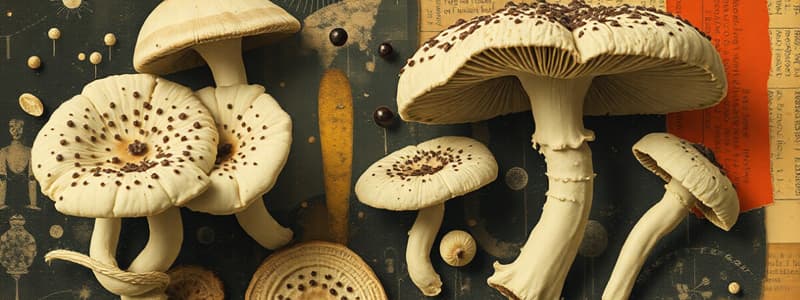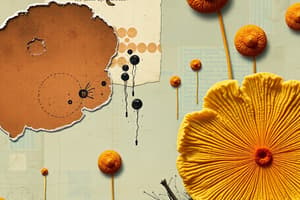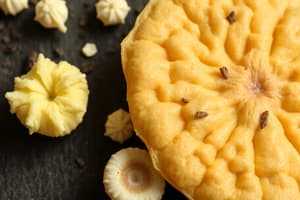Podcast
Questions and Answers
What structural feature distinguishes yeasts from moulds?
What structural feature distinguishes yeasts from moulds?
- Yeasts are unicellular. (correct)
- Yeasts are multicellular.
- Moulds are eukaryotic.
- Moulds form pseudohyphae.
In what type of environment can yeasts thrive?
In what type of environment can yeasts thrive?
- Only in aerobic conditions.
- Both aerobic and anaerobic conditions. (correct)
- Only in anaerobic conditions.
- Only in aquatic environments.
How do yeasts typically reproduce?
How do yeasts typically reproduce?
- Through both sexual and asexual reproduction. (correct)
- Strictly by asexual means.
- Primarily by releasing spores.
- Exclusively through binary fission.
Which of the following is a health risk associated with yeasts?
Which of the following is a health risk associated with yeasts?
What is the primary color appearance of yeasts?
What is the primary color appearance of yeasts?
What is the main reason yeasts may be found in certain habitats, such as fruit?
What is the main reason yeasts may be found in certain habitats, such as fruit?
What does the term 'dimorphic' refer to in the context of fungi?
What does the term 'dimorphic' refer to in the context of fungi?
Which of the following is a structural component unique to fungal cell walls?
Which of the following is a structural component unique to fungal cell walls?
What is the role of hyphae in fungi?
What is the role of hyphae in fungi?
Which feature is characteristic of moulds that is not applicable to yeasts?
Which feature is characteristic of moulds that is not applicable to yeasts?
What is the primary mode of reproduction for the organism that exhibits budding?
What is the primary mode of reproduction for the organism that exhibits budding?
What is the structure that forms when hyphae aggregate together?
What is the structure that forms when hyphae aggregate together?
Which of the following best describes the habitat where moulds typically thrive?
Which of the following best describes the habitat where moulds typically thrive?
What type of cells do moulds consist of?
What type of cells do moulds consist of?
Which characteristic is NOT associated with moulds?
Which characteristic is NOT associated with moulds?
What is the main health risk associated with mould exposure?
What is the main health risk associated with mould exposure?
What term describes chains of elongated budding cells?
What term describes chains of elongated budding cells?
Which of the following pigments can be associated with mould growth?
Which of the following pigments can be associated with mould growth?
Which process do moulds typically use for reproduction?
Which process do moulds typically use for reproduction?
Which component is found in the walls of fungal cells, including moulds?
Which component is found in the walls of fungal cells, including moulds?
Flashcards are hidden until you start studying
Study Notes
Fungi Characteristics
- Eukaryotic organisms.
- Most relevant fungus in dentistry: Candida.
- Exist in two structural forms: yeast (single-celled) and mold (multicelled).
- Some fungi are dimorphic (can exist as both yeast and mold).
- Fungal cell walls contain chitin.
Yeast Characteristics
- Grow as large, single cells.
- Unicellular.
- Common habitats: fruit, mammalian stomachs, oral cavities, and vaginal areas.
- Appearance: white, thready, usually oval.
- Do not have true hyphae; instead, form pseudohyphae (multicellular structures).
- Not a sporing species.
- Less colorful than molds (colorless to collectively creamy yellow).
- Can grow aerobically and anaerobically.
- Health risks: infections in immunocompromised individuals.
Yeast Reproduction
- Asexual reproduction:
- Spore release (through mycelial)
- Budding (daughter cells split from mother cell)
- Binary fission (in some species)
- Pseudohyphae (chains of elongated budding cells) formation, notably by Candida in the oral cavity.
Mold Characteristics
- Grow as multiple tubular branches.
- Multicellular.
- Habitats: damp, dark, or humid areas.
- Appearance: fuzzy, various shapes.
- Have microscopic filaments called hyphae.
- Sporing fungus.
- Very colorful (orange, green, black, brown, pink, or purple).
- Grows only aerobically.
- Health risks: allergic reactions and respiratory problems.
Mold Structure & Reproduction
- Multicellular, with hyphae (threads containing cytoplasm and organelles).
- Mycelium: a mass of hyphae forming the mold colony.
- Reproduction via spores (asexual or sexual).
Fungal Commensal Flora
- Information about specific locations and types of commensal fungal flora is missing from the provided text.
Studying That Suits You
Use AI to generate personalized quizzes and flashcards to suit your learning preferences.



